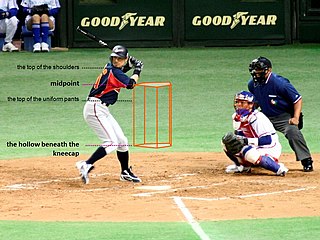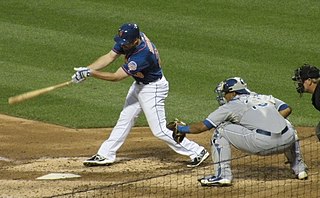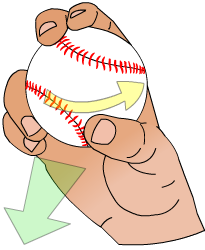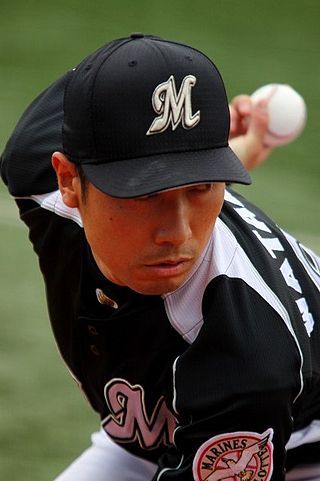
In baseball, the strike zone is the area of space through which a pitch must pass in order to be called a strike even if the batter does not swing. The strike zone is defined as the volume of space above home plate and between the batter's knees and the midpoint of their torso. Whether a pitch passes through the zone is decided by an umpire, who is generally positioned behind the catcher.

Softball is a popular variation of baseball, the difference being that it is played with a larger ball, on a smaller field, and with only underhand pitches permitted. Softball is played competitively at club levels, the college level, and the professional level. The game was first created in 1887 in Chicago by George Hancock.

A knuckleball or knuckler is a baseball pitch thrown to minimize the spin of the ball in flight, causing an erratic, unpredictable motion. The air flow over a seam of the ball causes the ball to change from laminar to turbulent flow. This change adds a deflecting force to the baseball, making it difficult for batters to hit but also difficult for pitchers to control and catchers to catch; umpires are challenged as well, as the ball's irregular motion through the air makes it harder to call balls and strikes. A pitcher who throws knuckleballs is known as a knuckleballer.

In baseball, the pitcher is the player who throws ("pitches") the baseball from the pitcher's mound toward the catcher to begin each play, with the goal of retiring a batter, who attempts to either make contact with the pitched ball or draw a walk. In the numbering system used to record defensive plays, the pitcher is assigned the number 1. The pitcher is often considered the most important player on the defensive side of the game, and as such is situated at the right end of the defensive spectrum. There are many different types of pitchers, such as the starting pitcher, relief pitcher, middle reliever, lefty specialist, setup man, and the closer.

Catcher is a position in baseball and softball. When a batter takes their turn to hit, the catcher crouches behind home plate, in front of the (home) umpire, and receives the ball from the pitcher. In addition to this primary duty, the catcher is also called upon to master many other skills in order to field the position well. The role of the catcher is similar to that of the wicket-keeper in cricket.

In baseball, a slider is a type of breaking ball, a pitch that moves or "breaks" as it approaches the batter. Due to the grip and wrist motion, the slider typically exhibits more lateral movement when compared to other breaking balls, such as the curveball.

In baseball and softball, the curveball is a type of pitch thrown with a characteristic grip and hand movement that imparts forward spin to the ball, causing it to dive as it approaches the plate. Varieties of curveball include the 12–6 curveball, power curveball, and the knuckle curve. Its close relatives are the slider and the slurve. The "curve" of the ball varies from pitcher to pitcher.

In baseball, a starting pitcher or starter is the first pitcher in the game for each team. A pitcher is credited with a game started if they throw the first pitch to the opponent's first batter of a game. Starting pitchers are expected to pitch for a significant portion of the game, although their ability to do this depends on many factors, including effectiveness, stamina, health, and strategy.

In baseball, the pitch is the act of throwing the baseball toward home plate to start a play. The term comes from the Knickerbocker Rules. Originally, the ball had to be thrown underhand, much like "pitching in horseshoes". Overhand pitching was not allowed in baseball until 1884.

A four-seam fastball, also called a rising fastball, a four-seamer, or a cross-seam fastball, is a pitch in baseball. It is a member of the fastball family of pitches and is usually the fastest ball thrown by a pitcher. It is called what it is because with every rotation of the ball as it is thrown, four seams come into view. A few pitchers at the major league level can sometimes reach a pitch speed of over 100 mph. It is often compared with the two-seam fastball.

In baseball, a circle changeup or circle change is a pitch thrown with a grip that includes a circle formation, hence the name circle changeup. The circle is formed by making a circle with the index finger, holding the thumb at the bottom of the ball parallel to the middle finger and holding the ball far out in the hand. The ball is thrown turning the palm out.

Throughout baseball's history, the rules have frequently changed as the game continues to evolve. A few common rules most professional leagues have in common are that four balls are a base on balls, three strikes are a strikeout, and three outs end a half-inning.
In baseball, an off-speed pitch is a pitch thrown at a slower speed than a fastball. Breaking balls and changeups are the two most common types of off-speed pitches. Very slow pitches which require the batter to provide most of the power on contact through bat speed are known as "junk" and include the knuckleball and the Eephus pitch, a sort of extreme changeup. The specific goals of off-speed pitches may vary, but in general they are used to disrupt the batter's timing, thereby lessening his chances of hitting the ball solidly or at all. Virtually all professional pitchers have at least one off-speed pitch in their repertoire. Despite the fact that most of these pitches break in some way, batters are sometimes able to anticipate them due to hints that the pitcher gives, such as changes in arm angle, arm speed, or placement of fingers.
A gyroball is a type of baseball pitch used primarily by players in Japan. It is thrown with a spiral-like spin, so that there is no Magnus force on the ball as it arrives at home plate. The gyroball is sometimes confused with the shuuto, another pitch used in Japan.
Cross-dominance, also known as mixed-handedness, hand confusion, or mixed dominance, is a motor skill manifestation in which a person favors one hand for some tasks and the other hand for others, or a hand and the contralateral leg. For example, a cross-dominant person might write with the left hand and do everything else with the right one, or manage and kick a ball preferentially with the left leg.
Overall, being mixed handed seems to result in better performance than being strongly handed for sports such as basketball, ice hockey, and field hockey. What these sports have in common is that they require active body movements and also an ability to respond to either side. The situation is reversed for racquet sports such as tennis. Individuals with crossed hand-eye preference seem to be much better at gymnastics, running, and basketball because of the way in which congruent and crossed sided individuals position their bodies.
The shuuto (シュート) or shootball is a baseball pitch. It is commonly thrown by right-handed Japanese pitchers such as Hiroki Kuroda, Noboru Akiyama, Kenjiro Kawasaki, Daisuke Matsuzaka, Yu Darvish and Masumi Kuwata. The most renowned shuuto pitcher in history was Masaji Hiramatsu, whose famous pitch was dubbed the razorshuuto because it seemed to "cut the air" when thrown.

Shunsuke Watanabe is a Japanese former professional baseball pitcher.

In baseball, sidearm is a motion for throwing a ball along a low, approximately horizontal plane rather than a high, mostly vertical plane (overhand).
This is an alphabetical list of selected unofficial and specialized terms, phrases, and other jargon used in baseball, along with their definitions, including illustrative examples for many entries.

The 12–6 curveball is one of the types of pitches thrown in baseball. It is categorized as a breaking ball because of its downward break. The 12–6 curveball, unlike the normal curveball, breaks in a downward motion in a straight line. This explains the name "12–6", because the break of the pitch refers to the ball breaking from the 12 o'clock position to 6 o'clock on a clock face. While the 11–5 and 2–8 variations are very effective pitches, they are less effective than a true 12–6, because the ball will break into the heart of the bat more readily.














